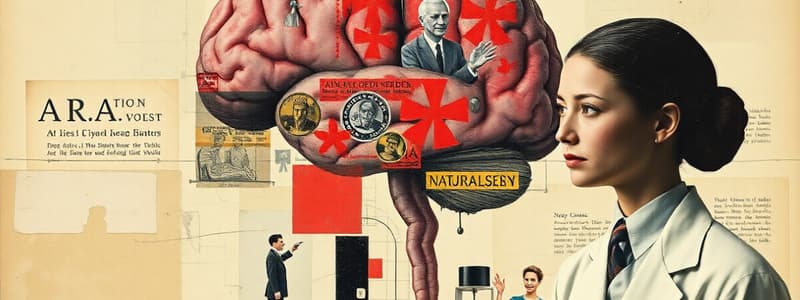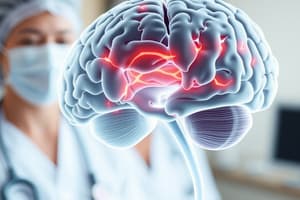Podcast
Questions and Answers
A patient presents with sudden onset of unilateral facial paralysis, drooping of the mouth, and difficulty closing the eye on the affected side. They deny any recent trauma. Which of the following is the MOST likely diagnosis?
A patient presents with sudden onset of unilateral facial paralysis, drooping of the mouth, and difficulty closing the eye on the affected side. They deny any recent trauma. Which of the following is the MOST likely diagnosis?
- Trigeminal Neuralgia
- Multiple Sclerosis
- Bell Palsy (correct)
- Cerebrovascular Event
An elderly patient is exhibiting progressive memory loss, confusion, and difficulty with problem-solving. Which of the following initial diagnostic steps is MOST important to rule out reversible causes of their cognitive decline?
An elderly patient is exhibiting progressive memory loss, confusion, and difficulty with problem-solving. Which of the following initial diagnostic steps is MOST important to rule out reversible causes of their cognitive decline?
- Lumbar puncture for CSF analysis
- MRI of the brain
- Comprehensive metabolic panel, B12 level, and thyroid function tests (correct)
- Referral to a neurologist for specialized cognitive testing
A patient with a history of hypertension and atherosclerosis presents with acute onset of dizziness, double vision, and difficulty swallowing. Which of the following conditions is MOST likely?
A patient with a history of hypertension and atherosclerosis presents with acute onset of dizziness, double vision, and difficulty swallowing. Which of the following conditions is MOST likely?
- Migrainous Vertigo
- Vertebrobasilar Insufficiency (correct)
- Benign Paroxysmal Positional Vertigo (BPPV)
- Meniere's Disease
A patient reports recurrent episodes of brief, intense, electric shock-like pain in the cheek that is triggered by touch, chewing, or talking. What is the MOST likely diagnosis?
A patient reports recurrent episodes of brief, intense, electric shock-like pain in the cheek that is triggered by touch, chewing, or talking. What is the MOST likely diagnosis?
A patient with Parkinson's Disease, currently managed with levodopa/carbidopa, develops motor fluctuations ('wearing off' effect) toward the end of the dosing interval. Which of the following strategies is MOST appropriate to consider first?
A patient with Parkinson's Disease, currently managed with levodopa/carbidopa, develops motor fluctuations ('wearing off' effect) toward the end of the dosing interval. Which of the following strategies is MOST appropriate to consider first?
A young adult female presents with fatigue, numbness and tingling in her extremities, vision changes, and muscle weakness that have occurred over the past several weeks. MRI reveals multiple areas of demyelination in the brain and spinal cord. Which of the following is the MOST likely diagnosis?
A young adult female presents with fatigue, numbness and tingling in her extremities, vision changes, and muscle weakness that have occurred over the past several weeks. MRI reveals multiple areas of demyelination in the brain and spinal cord. Which of the following is the MOST likely diagnosis?
A patient being evaluated for possible seizure disorder experiences an event including loss of consciousness, rigidity, and rhythmic jerking movements. After the event, the patient is confused and reports tongue biting. What type of seizure is the patient MOST likely experiencing?
A patient being evaluated for possible seizure disorder experiences an event including loss of consciousness, rigidity, and rhythmic jerking movements. After the event, the patient is confused and reports tongue biting. What type of seizure is the patient MOST likely experiencing?
A patient diagnosed with an intracranial tumor is experiencing increased intracranial pressure. Which of the following clinical manifestations would be MOST concerning and require immediate intervention?
A patient diagnosed with an intracranial tumor is experiencing increased intracranial pressure. Which of the following clinical manifestations would be MOST concerning and require immediate intervention?
Flashcards
Amyotrophic Lateral Sclerosis (ALS)
Amyotrophic Lateral Sclerosis (ALS)
Progressive neurodegenerative disease that affects motor neurons in the brain and spinal cord.
Bell Palsy
Bell Palsy
Sudden weakness or paralysis of the muscles on one side of the face due to dysfunction of the facial nerve (CN VII).
Cerebrovascular Events (Stroke)
Cerebrovascular Events (Stroke)
Neurological deficits caused by interruption of blood supply to the brain.
Dementia
Dementia
Signup and view all the flashcards
Dizziness and Vertigo
Dizziness and Vertigo
Signup and view all the flashcards
Guillain-Barré Syndrome (GBS)
Guillain-Barré Syndrome (GBS)
Signup and view all the flashcards
Headache
Headache
Signup and view all the flashcards
Infections of the Central Nervous System (CNS)
Infections of the Central Nervous System (CNS)
Signup and view all the flashcards
Study Notes
- Primary Care covers a wide range of topics from adolescence through adulthood, health promotion, and emergent care.
- It includes the evaluation and management of various disorders related to the skin, eyes, ears, nose, and oropharynx.
- Pulmonary, cardiovascular, gastrointestinal, genitourinary, and gynecologic disorders are discussed.
- Musculoskeletal, arthritic, and neurologic disorders are covered in detail.
- The text addresses endocrine, metabolic, rheumatic, and multisystem disorders.
- Infectious, hematologic, and oncologic diseases, as well as mental health disorders, are included.
Neurologic Disorders
- Amyotrophic Lateral Sclerosis (ALS) is discussed.
- Bell Palsy, a form of facial paralysis, is reviewed.
- Cerebrovascular events, including stroke, are covered.
- Dementia and its various forms are addressed.
- Dizziness and vertigo are examined as common neurological symptoms.
- Guillain-Barré Syndrome, an autoimmune disorder affecting the peripheral nerves, is included.
Headache
- Different types of headaches, their evaluation, and management are discussed.
Infections of the Central Nervous System
- Infections such as meningitis and encephalitis are addressed.
Movement Disorders and Essential Tremor
- Conditions affecting movement and causing tremors are reviewed.
Multiple Sclerosis
- An autoimmune disease affecting the brain and spinal cord.
Parkinson Disease
- A progressive disorder affecting movement.
Seizure Disorder
- Including epilepsy, its diagnosis, and management.
Trigeminal Neuralgia
- A chronic pain condition affecting the trigeminal nerve.
Intracranial Tumors
- Tumors located within the skull and their management.
Hematologic Disorders
- Anemia, a condition characterized by a deficiency of red blood cells or hemoglobin.
- Blood Coagulation Disorders, affecting the body's ability to form blood clots.
- Leukemias, cancers of the blood and bone marrow.
- Lymphomas, cancers that begin in the lymphatic system.
- Myelodysplastic Syndromes, a group of disorders in which the bone marrow does not produce enough healthy blood cells.
Studying That Suits You
Use AI to generate personalized quizzes and flashcards to suit your learning preferences.
Description
An overview of neurologic disorders in primary care, including ALS, Bell Palsy, cerebrovascular events, dementia, dizziness, vertigo, and Guillain-Barré Syndrome. This lesson covers their evaluation and management. Useful for medical students and healthcare professionals.



